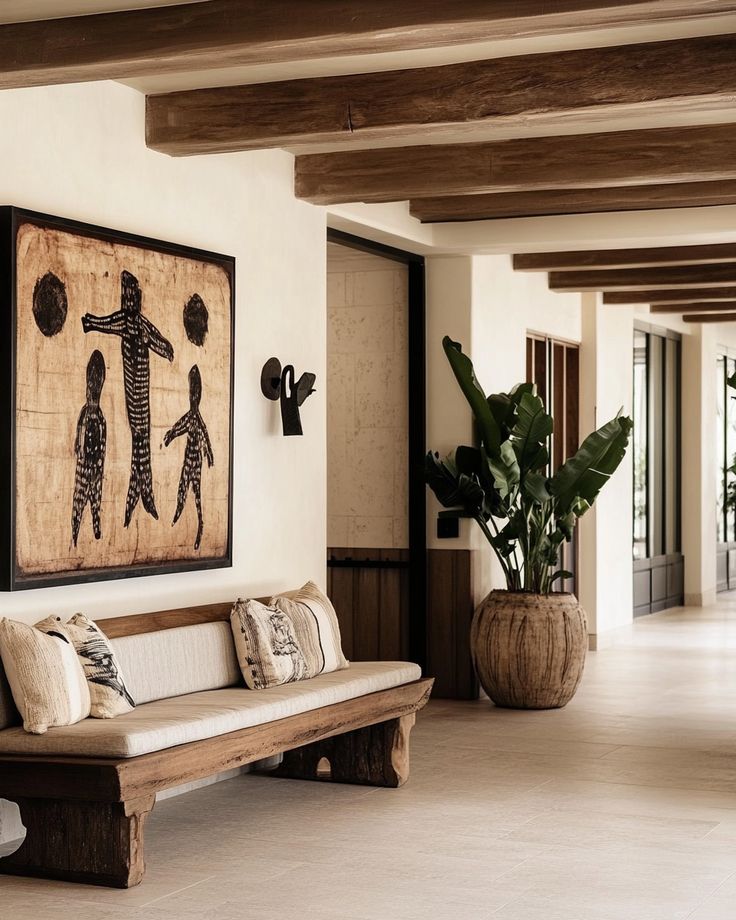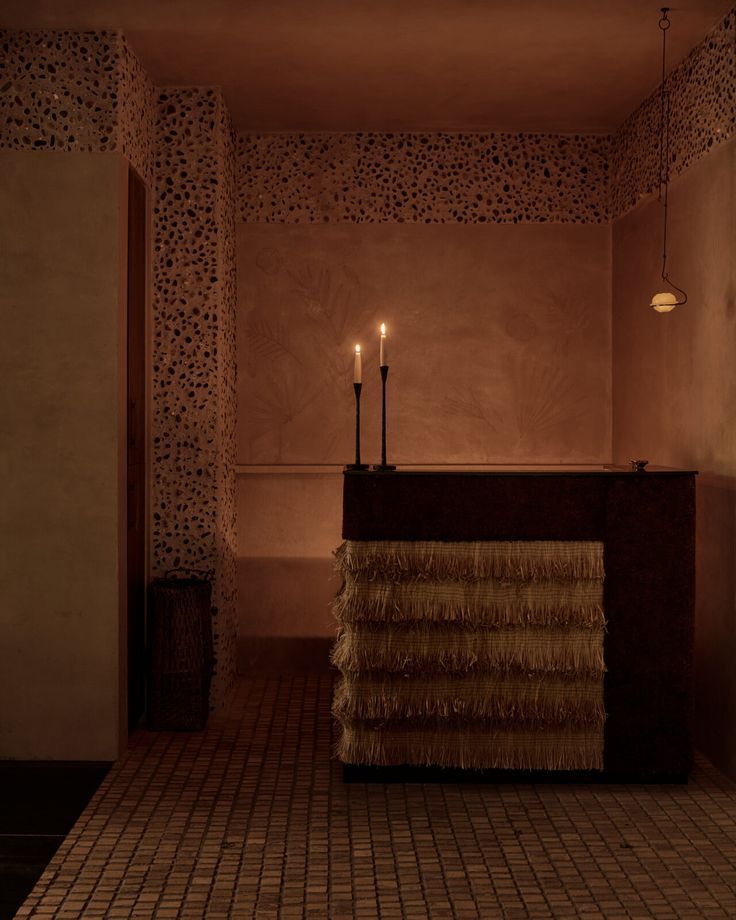
The Essence of African Interior Design
African interior design embodies bold textures, natural materials, and rich storytelling woven into every detail. This aesthetic, deeply rooted in tradition, continues to shape modern interiors worldwide. From the rhythmic patterns of Mudcloth and Kente textiles to the raw beauty of handcrafted furniture, African influence transforms homes into soulful sanctuaries filled with history and artistry.
But what makes African interior design so timeless? And how can you seamlessly integrate its influence into your space? This guide explores the cultural significance, key design elements, and practical ways to incorporate African-inspired decor into modern interiors.
The Cultural Influence of African Interior Design
Africa’s design legacy reflects a deep connection to nature, community, and craftsmanship. Every motif, material, and structure carries meaning—a visual language passed down through generations.
1. The Art of Storytelling Through Textiles
African textiles go beyond aesthetics; they tell ancestral stories, honor traditions, and symbolize status. The most iconic textiles include:
- Kente Cloth (Ghana) – A symbol of royalty, wisdom, and heritage, with bold geometric patterns and vibrant colors.
- Mudcloth (Mali) – Handwoven cotton fabric dyed with fermented mud, featuring earthy tones and symbolic markings.
- Aso Oke (Nigeria) – A richly textured, handwoven fabric often used in traditional Yoruba ceremonies, now a luxury upholstery choice.
Design Tip: Use framed Kente cloth as wall art or incorporate Mudcloth into throw pillows and bedding for a warm, organic feel.
2. Natural Materials and Handcrafted Elements
African interiors celebrate nature through organic materials that bring warmth and texture to a space. Key elements include:
- Woven Baskets & Grass Rugs – Handwoven from sisal, raffia, or palm leaves, these pieces add depth and cultural authenticity.
- Carved Wooden Furniture – Featuring intricate patterns and curved silhouettes, African-inspired furniture showcases impeccable craftsmanship.
- Clay & Terracotta Accents – Whether in sculptural vases or textured wall finishes, earthy ceramics evoke traditional African homesteads.
Design Tip: Mix textures—pair a handwoven rug with carved wooden stools or add terracotta planters for an effortless blend of African influences.
3. Earthy and Vibrant Color Palettes
African-inspired interiors balance neutral earth tones with bold, energetic hues. Key color elements include:
- Earthy Neutrals – Ochre, sandy beige, deep brown, and clay tones create a grounded, calming atmosphere.
- Vibrant Accents – Sun-kissed oranges, deep indigos, and burnt reds evoke the continent’s rich landscapes and cultural vibrancy.
- High-Contrast Black & White – Seen in Mudcloth patterns, this timeless combination adds a sophisticated and graphic appeal.
Design Tip: Use neutral walls as a backdrop and introduce African textiles, artwork, or furniture as statement pieces to add depth and contrast.
How to Integrate African Interior Design in Modern Spaces
Bringing African design influence into your home doesn’t require a complete overhaul. Thoughtful additions create a harmonious blend of heritage and contemporary style.
1. African-Inspired Statement Walls
Create a bold statement with:
- Textile Wall Hangings – Frame Mudcloth or Kente fabric for a striking yet minimalist focal point.
- Hand-Painted Murals – Incorporate geometric African motifs or nature-inspired designs.
- Natural Clay or Lime-Washed Walls – Add texture and warmth reminiscent of traditional African architecture.
2. Sculptural Furniture & Handwoven Elements
Invest in handcrafted African furniture that prioritizes organic shapes and materials. Consider:
- Curved Wooden Chairs & Stools – Inspired by traditional seating used in Senegalese and Ghanaian homes.
- Woven Ceiling Pendants – Rattan and bamboo lighting fixtures provide an airy, textured look.
- Handwoven Baskets for Storage – Functional yet decorative, they bring warmth to any room.
Design Tip: Use a large woven pendant light over a dining table to introduce texture and cultural depth.
3. African-Inspired Walk-In Closets & Dressing Spaces
African aesthetics extend beyond living areas into luxurious walk-in closets and dressing rooms. Design elements include:
- Carved Wooden Storage Units – Adds character while preserving traditional craftsmanship.
- Bold Textile-Covered Stools – Mudcloth or Kente-upholstered seating brings a curated look.
- Handmade Woven Baskets – Ideal for organizing accessories while maintaining an authentic African touch.
Design Tip: Pair dark wood cabinetry with brass accents for a luxe, Afro-modern aesthetic.
Why African Interior Design Continues to Influence Global Trends
Interior designers worldwide embrace African-inspired decor for its timeless elegance, sustainability, and cultural depth. Here’s why it remains relevant:
- Authenticity & Handmade Craftsmanship – African interiors prioritize handmade over mass-produced, aligning with today’s demand for sustainable luxury.
- Textural Diversity & Layered Spaces – The combination of woven textures, wooden carvings, and bold prints creates visually rich, inviting interiors.
- Versatility Across Design Styles – Whether bohemian, minimalist, or high-end luxury, African elements seamlessly integrate into modern interiors.
Expert Insight: According to Elle Decor, designers are increasingly blending African textiles and materials into high-end interiors, merging cultural heritage with contemporary aesthetics. A great example of that is seen in here with some of the most talented furniture designers from the continent.
Final Thoughts on Designing with Soul and Heritage
African interior design offers more than just visual beauty—it invites depth, culture, and storytelling into modern homes. Whether through woven textiles, sculptural furniture, or earthy color palettes, this aesthetic transforms interiors into thoughtful, art-filled sanctuaries.
By incorporating African influences, you don’t just decorate; you honor craftsmanship, celebrate tradition, and create a space that feels truly alive.
Explore the rich world of African design—start curating a space filled with heritage, artistry, and warmth today.
+ view the comments




Hi, this is a comment.
To get started with moderating, editing, and deleting comments, please visit the Comments screen in the dashboard.
Commenter avatars come from Gravatar.